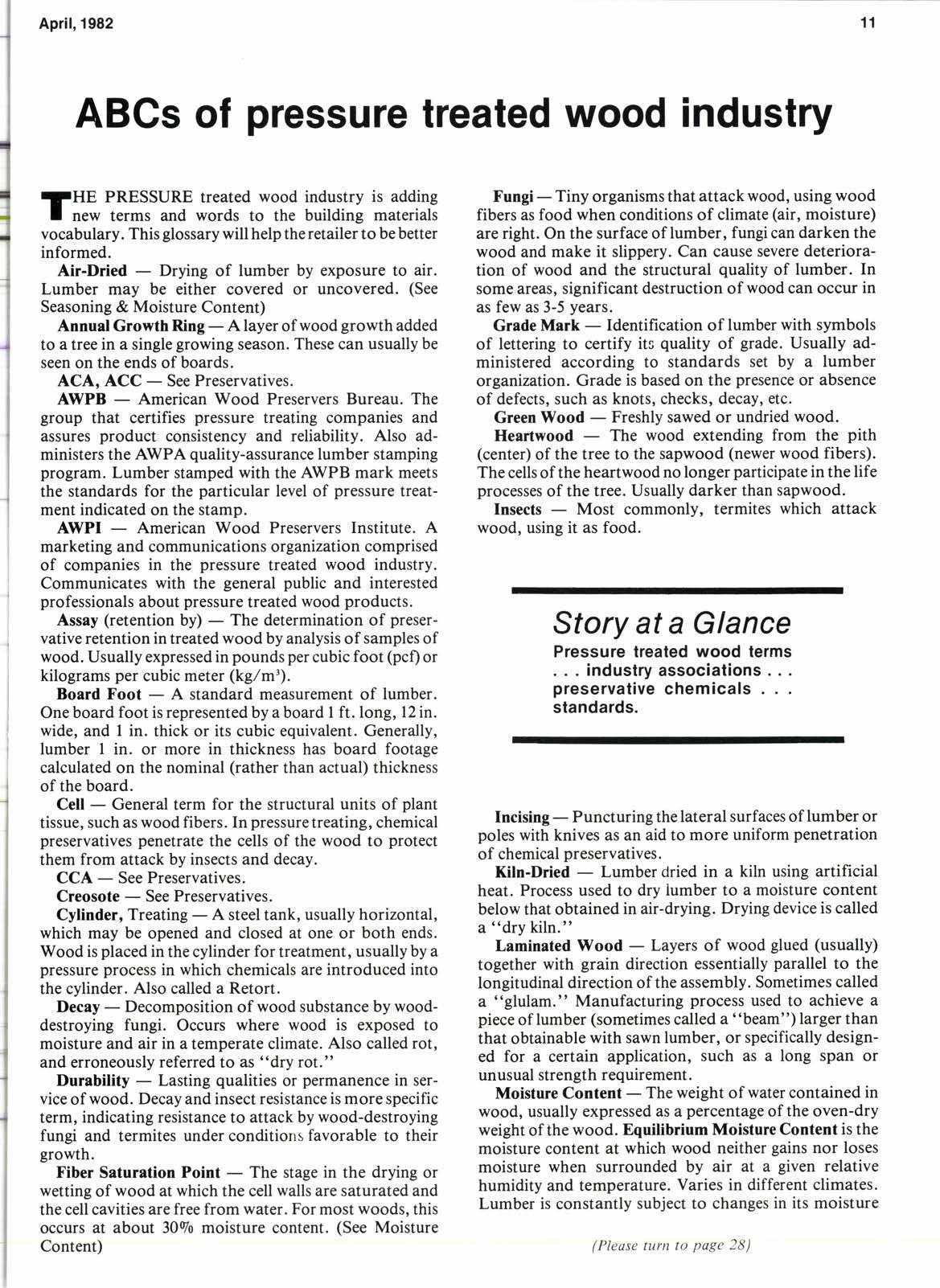
3 minute read
ABCs of pressure treated wood industry
IIHE PRESSURE treated wood industry is adding I new terms and words to the building materials vocabulary. This glossary will help the retailer to be better informed.
Air-Dried - Drying of lumber by exposure to air. Lumber may be either covered or uncovered. (See Seasoning & Moisture Content)
Annual Growth RingA layer of wood growth added to a tree in a single growing season. These can usually be seen on the ends of boards.
ACA, ACCSee Preservatives.
AWPBAmerican Wood Preservers Bureau. The group that certifies pressure treating companies and assures product consistency and reliability. Also administers the AWPA quality-assurance lumber stamping program. Lumber stamped with the AWPB mark meets the standards for the particular level of pressure treatment indicated on the stamp.
AWPIAmerican Wood Preservers Institute. A marketing and communications organization comprised of companies in the pressure treated wood industry. Communicates with the general public and interested professionals about pressure treated wood products.
Assay (retention by)The determination of preservative retention in treated wood by analysis of samples of wood. Usually expressed in pounds per cubic foot (pcf) or kilograms per cubic meter (kglm3).
Board FootA standard measurement of lumber. One board foot is represented by a board I ft. long, 12 in. wide, and I in. thick or its cubic equivalent. Generally, lumber I in. or more in thickness has board footage calculated on the nominal (rather than actual) thickness of the board.
CellGeneral term for the structural units of plant tissue, such as wood fibers. In pressuretreating, chemical preservatives penetrate the cells of the wood to protect them from attack by insects and decay.
CCASee Preservatives.
CreosoteSee Preservatives.
Cylinder, TreatingA steel tank, usually horizontal, which may be opened and closed at one or both ends. Wood is placed in the cylinder for treatment, usually by a pressure process in which chemicals are introduced into the cylinder. Also called a Retort.
DecayDecomposition of wood substance by wooddestroying fungi. Occurs where wood is exposed to moisture and air in a temperate climate. Also called rot, and erroneously referred to as "dry rot."
DurabilityLasting qualities or permanence in service of wood. Decay and insect resistance is more specific term, indicating resistance to attack by wood-destroying fungi and termites under conditions favorable to their growth.
Fiber Saturation PointThe stage in the drying or wetting of wood at which the cell walls are saturated and the cell cavities are free from water. For most woods, this occurs at about 3090 moisture content. (See Moisture Content)
Fungi - Tiny organisms that attack wood, using wood fibers as food when conditions of climate (air, moisture) are right. On the surface of lumber, fungi can darken the wood and make it slippery. Can cause severe deterioration of wood and the structural quality of lumber. In some areas, significant destruction of wood can occur in as few as 3-5 years.
Grade MarkIdentification of lumber with symbols of lettering to certify its quality of grade. Usually administered according to standards set by a lumber organization. Grade is based on the presence or absence of defects, such as knots, checks, decay, etc.
Green WoodFreshly sawed or undried wood.
HeartwoodThe wood extending from the pith (center) of the tree to the sapwood (newer wood fibers). The cells of the heartwood no longer participate in the life processes of the tree. Usually darker than sapwood.
InsectsMost commonly, termites which attack wood, using it as food.
Story at a Glance
Pressure treated wood terms industry associations preservative chemacals standards.
IncisingPuncturing the lateral surfaces of lumber or poles with knives as an aid to more uniform penetration of chemical preservatives.
Kiln-DriedLumber dried in a kiln using artificial heat. Process used to dry lumber to a moisture content below that obtained in air-drying. Drying device is called a "dry kiln."
Laminated T9ood - Layers of wood glued (usually) together with grain direction essentially parallel to the longitudinal direction of the assembly. Sometimes called a "glulam." Manufacturing process used to achieve a piece of lumber (sometimes called a "beam") larger than that obtainable with sawn lumber, or specifically designed for a certain application, such as a long span or unusual strength requirement.
Moisture ContentThe weight of water contained in wood, usually expressed as a percentage of the oven-dry weight of the wood. Equilibrium Moisture Content is the moisture content at which wood neither gains nor loses moisture when surrounded by air at a given relative humidity and temperature. Varies in different climates. Lumber is constantly subject to changes in its moisture









